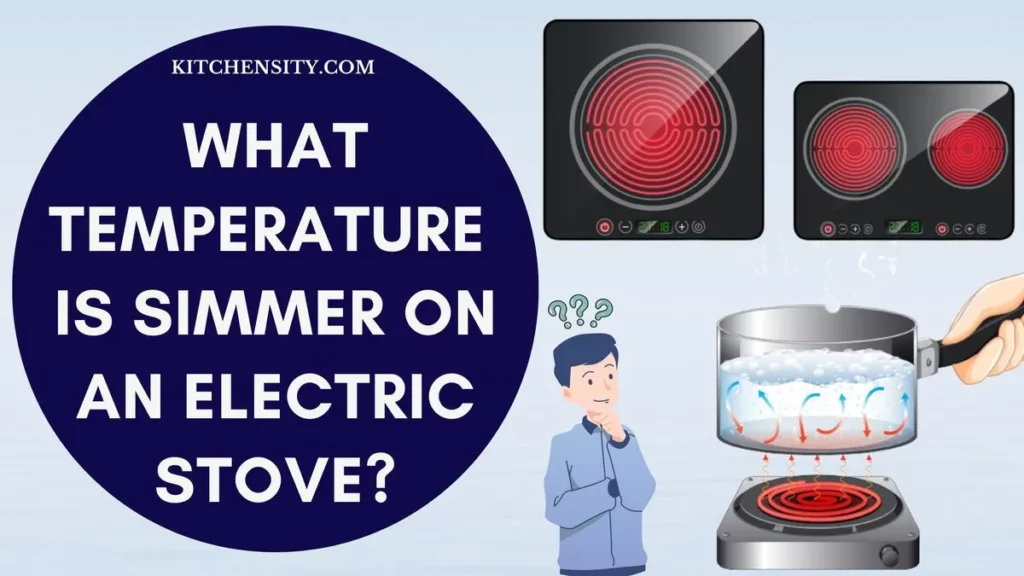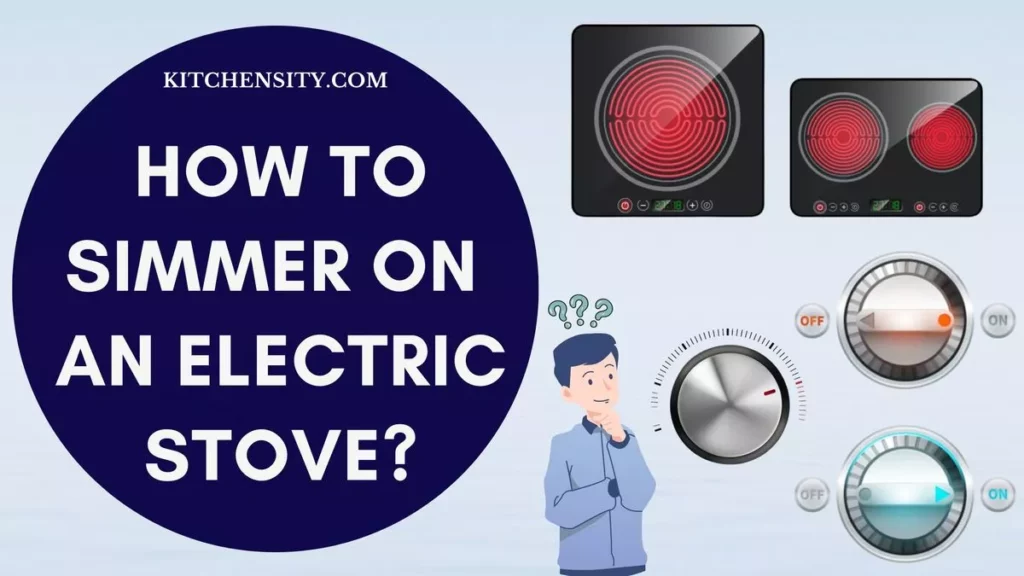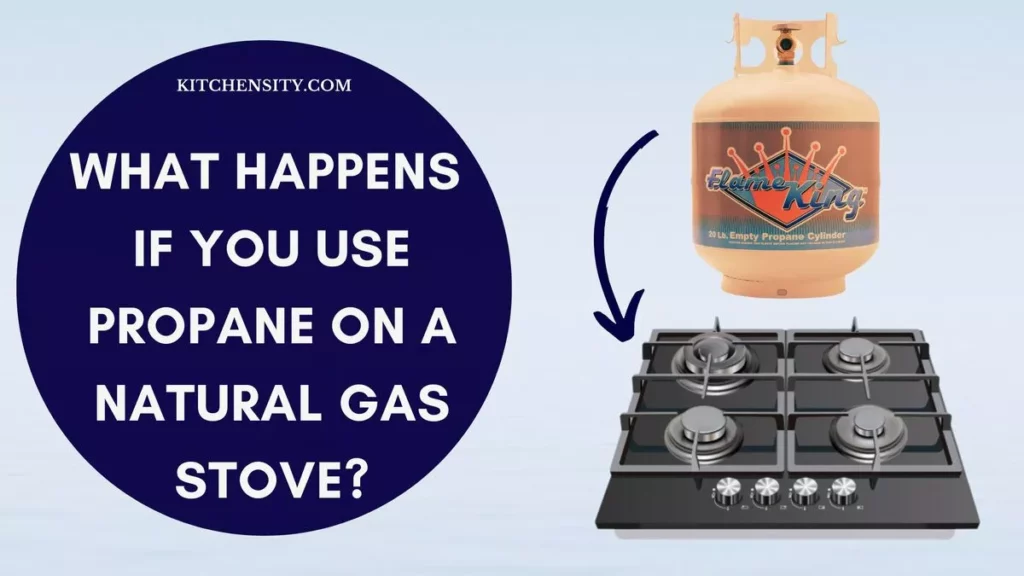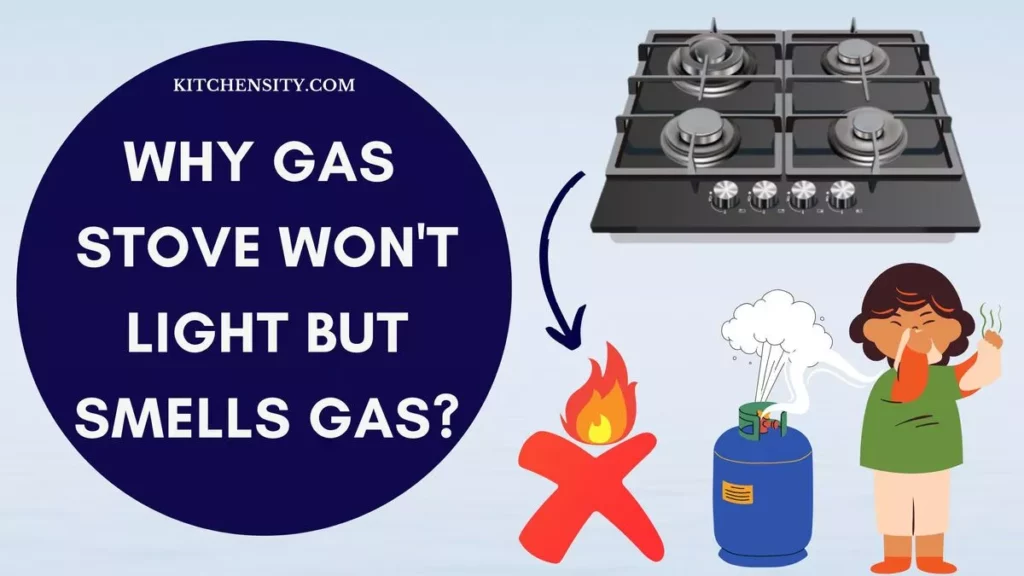Gas stoves have long been a reliable companion in our kitchens, offering quick and efficient cooking.
One of the key features that make them user-friendly is the clicking sound they make when you turn the knob to ignite the burner. However, what do you do when your trusty gas stove remains eerily silent?
In this article, we will explore common reasons why your gas stove is not clicking and what you can do about it.
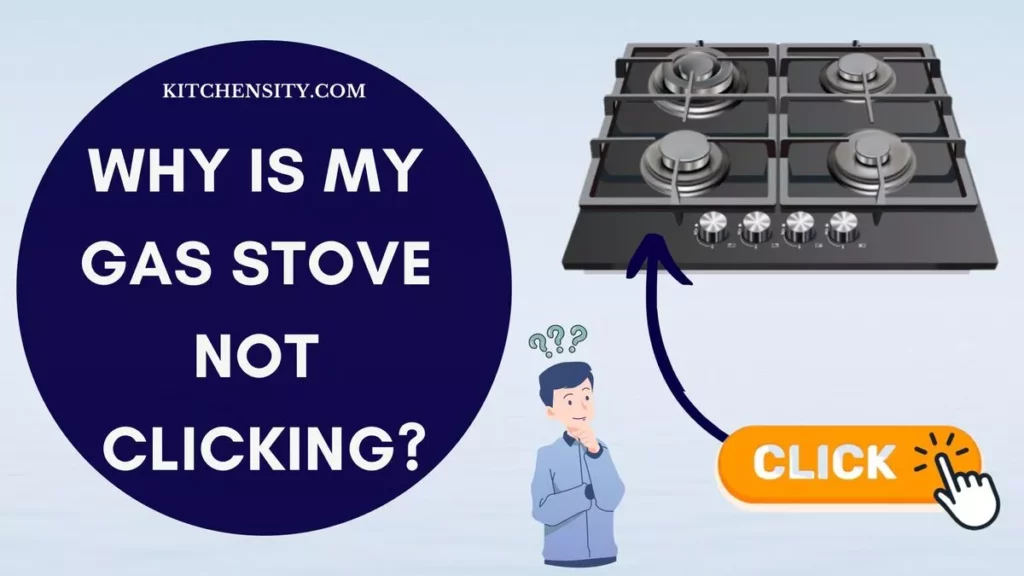
Table of Contents
- 1 Why Is My Gas Stove Not Clicking?
- 2 How To Fix The Issue Of Gas Stove Not Clicking?
- 3 Why Is My Gas Stove Not Clicking After Cleaning?
- 4 When To Seek Professional Help?
- 5 How Do I Know If My Spark Module Is Bad?
- 6 Safety Precautions To Take When Fixing Gas Stove Not Clicking
- 7 Regular Maintenance Tips For Gas Stoves
- 8 Final Verdict On Gas Stove Not Clicking
- 9 FAQs (Frequently Asked Questions)
- 9.1 Can I Manually Light My Gas Stove If The Ignition Isn’t Working?
- 9.2 Is It Safe To Attempt Diy Troubleshooting On A Gas Stove?
- 9.3 Why Does My Gas Stove Click Continuously Even After Igniting?
- 9.4 Can A Gas Stove Make A Clicking Sound When It’s Not In Use?
- 9.5 What Should I Do If I Suspect A Gas Leak From My Stove?
Why Is My Gas Stove Not Clicking?
Your gas stove may not be clicking due to several possible reasons: the pilot light is out, igniter components are dirty or clogged, the spark module is faulty, there are gas supply issues, or safety features are interrupting the ignition process.
Also Read – Why Gas Stove Won’t Light But Smells Gas?
A silent gas stove, one that doesn’t produce the familiar clicking sound when you try to ignite it, can be a perplexing issue for any homeowner or chef. There are several reasons why your gas stove might remain silent, each stemming from various components and aspects of the stove’s functionality.
Let’s delve into these reasons in more detail:
- The Pilot Light Is Out:
- Many older gas stoves rely on a constantly burning pilot light. This pilot light is responsible for igniting the main burner when you turn the knob.
- If the pilot light is extinguished, your stove won’t click.
- Common reasons for a pilot light going out include drafts, clogs, or simply the pilot light aging and needing to be relit.
- Dirty Or Clogged Igniter Components:
- Over time, the igniter components, including the burner and electrode, can accumulate grease, debris, and residue from cooking.
- This build-up can inhibit the proper flow of gas and prevent the spark needed for ignition.
- Cleaning these components can often restore the clicking sound and ensure the stove ignites reliably.
- Faulty Spark Module:
- Modern gas stoves typically use a spark module to generate the spark needed for ignition.
- If this module malfunctions, it won’t send the necessary electrical signal to the igniter.
- Consequently, there will be no clicking sound, and the burner won’t light. Replacing a faulty spark module is a common fix for this issue.
- Gas Supply Issues:
- Sometimes, the issue might not be with the stove itself but with the gas supply.
- Low gas pressure or a partially closed gas valve can prevent proper ignition.
- It’s essential to ensure that the gas supply line is fully open, and the pressure is within the manufacturer’s recommended range.
- Safety Features:
- Many modern gas stoves are equipped with safety features designed to prevent gas leaks and protect users.
- These features may include thermocouples or flame sensors that monitor the presence of a flame.
- If these components detect an issue, they may interrupt the clicking and prevent the gas from flowing.
Understanding these common reasons for a silent gas stove can help you troubleshoot and address the issue effectively. It’s crucial to approach troubleshooting with caution, prioritizing safety at all times.
If you’re uncertain about any aspect of troubleshooting your gas stove or if the problem persists after attempting DIY solutions, it’s advisable to seek professional help to ensure the safety and reliability of your appliance.
Also Read – How To Fix A Yellow Flame On A Gas Stove?
How To Fix The Issue Of Gas Stove Not Clicking?
Fixing the issue of a gas stove not clicking can often be done through a series of troubleshooting steps. Before you begin, ensure that you follow safety precautions such as turning off the gas supply and ensuring proper ventilation in your kitchen.
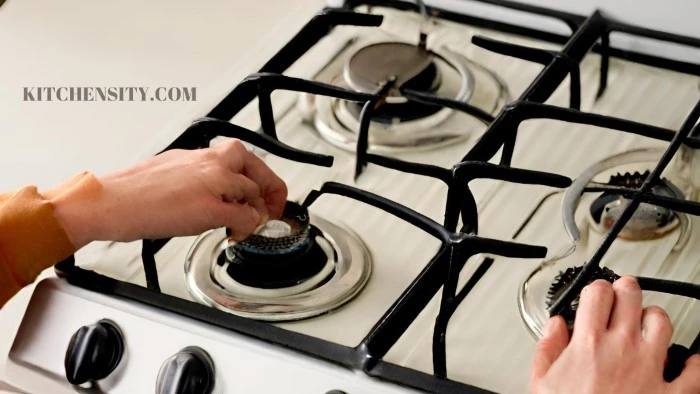
Here’s a step-by-step guide to help you address the problem:
- Check The Pilot Light (If Applicable): If your gas stove has a pilot light, make sure it’s lit. If it’s out, follow these steps to relight it:
- Turn the gas control knob to the “Off” position.
- Wait for a few minutes to allow any accumulated gas to dissipate.
- Locate the pilot light (usually at the back of the stove).
- Use a long lighter or matchstick to carefully relight the pilot light while holding down the knob in the “Pilot” position.
- Once the pilot light is lit, continue holding the knob for about 30 seconds to ensure it stays lit, and then release it.
- Clean The Igniter Components:
- Turn off the gas supply to the stove.
- Remove the burner grates and caps.
- Access the igniter components, which are usually located near the burners.
- Use a soft brush or a cloth to clean the igniter, burner, and electrode carefully.
- Ensure that there is no grease, debris, or residue blocking the spark.
- Inspect The Spark Module:
- Locate the spark module, usually beneath the stove’s top panel or in a nearby control panel.
- Check for loose or disconnected wires. Reconnect any loose wires securely.
- If you suspect a faulty spark module, consider replacing it. Refer to your stove’s manual for guidance or seek professional assistance.
- Ensure Proper Gas Supply:
- Verify that the gas supply valve for the stove is fully open.
- Check for any obstructions or kinks in the gas supply line.
- Test other gas appliances in your home to ensure there are no gas supply issues.
- Safety Features And Thermocouples:
- Some stoves have safety features like thermocouples that monitor the presence of a flame.
- If they malfunction, they may prevent ignition. Inspect these components and replace them if necessary.
- Reassemble And Test:
- After cleaning and making any necessary repairs or adjustments, reassemble the stove components, including the burner grates and caps.
- Turn on the gas supply and test the stove by turning a burner knob to the “Light” position.
- You should hear the clicking sound, and the burner should ignite. If it doesn’t, recheck the components and connections.
- Seek Professional Help If Needed:
- If the issue persists or if you’re uncomfortable with any aspect of troubleshooting, it’s best to contact a qualified technician or a professional appliance repair service.
- Gas-related issues, especially those involving gas leaks or complex electrical problems, should be addressed by experts to ensure safety.
Remember, safety should always be a priority when dealing with gas appliances. If you ever smell gas or suspect a gas leak, immediately turn off the gas supply, ventilate the area, and contact your gas utility provider or a licensed professional for assistance.
Also Read – Do Gas Stoves Turn Off Automatically?
Why Is My Gas Stove Not Clicking After Cleaning?
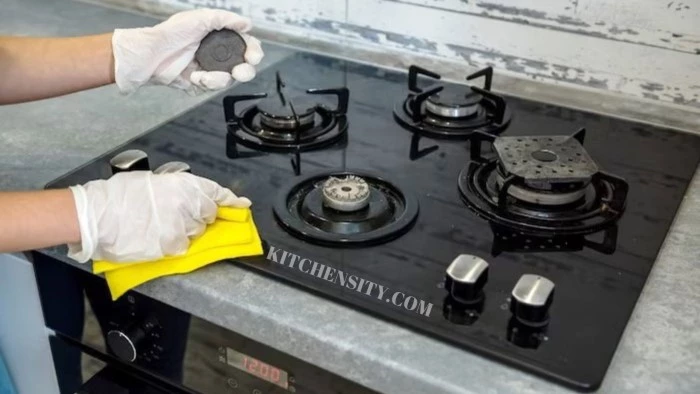
If your gas stove is not clicking after cleaning, and you’ve recently cleaned the igniter components, there could be a few reasons why this issue persists. Let’s explore possible causes and solutions:
- Moisture Or Residue: Sometimes, during the cleaning process, moisture or cleaning residue can affect the igniter’s performance. Ensure that the igniter components are completely dry and free from any cleaning residue.
- Solution: Allow the igniter components to air dry thoroughly. You can also use a hairdryer on a low, cool setting to speed up the drying process. Make sure there is no residue left on the igniter, burner, or electrode.
- Improper Reassembly: If you disassembled any parts of the gas stove during cleaning and did not reassemble them correctly, this can affect the stove’s ignition.
- Solution: Double-check that all components, including burner caps, grates, and any other removed parts, are reassembled correctly. Ensure they are seated securely in their proper positions.
- Worn Or Damaged Components: Over time, igniter components like the electrode or spark module can wear out or become damaged. Cleaning may not resolve the issue if these components are faulty.
- Solution: Inspect the igniter components for signs of damage or wear. If you notice any issues, such as visible damage or worn-out parts, consider replacing them. Refer to your stove’s manual for guidance on replacing components, or seek professional assistance.
- Gas Flow Issues: If there are problems with the gas supply, such as low gas pressure or a partially closed gas valve, the stove may not ignite, even if the clicking sound is heard.
- Solution: Verify that the gas supply valve is fully open and that there are no obstructions or kinks in the gas line. If you suspect a gas flow issue, contact your gas utility provider for assistance.
- Safety Features Activation: Some modern gas stoves are equipped with safety features that may interrupt the ignition process if an issue is detected. These features can include thermocouples or flame sensors.
- Solution: Check the stove’s manual for information on safety features and their operation. If a safety feature has been activated due to a problem, it may require professional diagnosis and reset.
- Electrical Issues: If there are electrical problems, such as a faulty spark module or wiring issues, it can prevent the igniter from working correctly.
- Solution: If you suspect electrical issues, it’s advisable to have a professional technician diagnose and repair the problem. Electrical problems can be complex and should be handled by experts.
If you’ve checked these potential causes and the gas stove still isn’t clicking, despite having cleaned it, it may be time to seek professional help.
A qualified technician can perform a more in-depth inspection, identify the root cause of the issue, and perform any necessary repairs or component replacements to ensure your stove functions properly.
Also Read – How Long Can You Leave An Electric Stove On?
When To Seek Professional Help?
Seeking professional help for issues with your gas stove is crucial in several situations to ensure safety, proper repairs, and the continued reliable performance of your appliance. Here are some scenarios when it’s advisable to contact a qualified technician or a professional appliance repair service:
- Gas Leaks Or Suspected Gas Leaks: If you smell gas or suspect a gas leak from your gas stove, do not attempt to fix the issue yourself. Gas leaks are extremely dangerous and require immediate attention. Follow these steps:
- Turn off the gas supply to the stove.
- Evacuate your home, ensuring that no one uses electrical switches or creates sparks.
- Contact your gas utility provider and emergency services.
- Do not re-enter your home until it’s declared safe by a professional.
- Complex Electrical Issues:
- If you suspect complex electrical problems within your gas stove, such as issues with the wiring, control board, or spark module, it’s best to leave the diagnosis and repair to a qualified technician.
- Working with electrical components without the necessary expertise can be risky.
- Inconsistent Or Weak Flame:
- If your gas stove ignites but produces an inconsistent or weak flame, this could indicate a more serious problem with the gas flow, regulator, or burner components.
- A professional inspection is advisable to pinpoint and address the issue correctly.
- Persistent Ignition Problems:
- If you’ve attempted basic troubleshooting steps, including cleaning igniter components and checking the gas supply, but the stove’s ignition problem persists, it’s time to involve a professional.
- Ongoing issues may indicate deeper underlying problems that require expert diagnosis and repair.
- Safety Features And Thermocouple Malfunctions: If safety features like thermocouples or flame sensors are malfunctioning and preventing your gas stove from igniting a professional technician can assess and replace these components as needed to ensure safe operation.
- Manufacturer’s Warranty: If your gas stove is still under warranty, attempting DIY repairs or hiring an unauthorized technician may void the warranty. It’s usually best to contact the manufacturer’s authorized service provider for warranty-related issues.
- Gas Appliance Maintenance And Inspections: Regular maintenance and safety inspections of your gas stove are essential to prevent potential problems. Consider scheduling periodic inspections by a qualified technician to identify and address issues before they escalate.
- Diy Troubleshooting Challenges: If you’re not comfortable with the troubleshooting steps or if the problem remains unresolved after your attempts, it’s wise to seek professional help. Incorrectly diagnosing or repairing gas stove issues can lead to safety hazards and costly repairs.
When seeking professional help, make sure to hire a licensed and experienced technician or appliance repair service that specializes in gas stoves. They have the expertise, tools, and knowledge to safely diagnose and fix a wide range of issues, ensuring the safety and functionality of your appliance.
Also Read – How Hot Do Electric Stove Burners Get?
How Do I Know If My Spark Module Is Bad?
If you suspect that your spark module is bad and causing issues with your gas stove’s ignition, there are several signs and symptoms to look for. Here’s how to determine if your spark module is likely malfunctioning:
- No Clicking Sound: One of the most apparent signs of a faulty spark module is the absence of the clicking sound when you turn the stove’s burner knobs to the “Light” position. Normally, the spark module generates a series of rapid clicks to ignite the gas.
- Inconsistent Ignition: If you notice that some burners on your gas stove ignite while others do not, or if the ignition is sporadic and unpredictable, it could be indicative of a failing spark module.
- Delayed Ignition: A spark module in poor condition may cause an ignition delay, meaning the spark occurs after you’ve turned the burner knob to the “Light” position. This delay can result in a slower start to cooking.
- Continuous Clicking: On the flip side, a malfunctioning spark module might lead to continuous clicking even after the burner has ignited. This persistent clicking can be both annoying and a clear sign of a problem.
- Burner Not Lighting At All: If a specific burner consistently fails to ignite, even after you’ve tried multiple times and verified that the gas supply is adequate, the spark module for that burner may be defective.
- Visual Inspection: Sometimes, you may observe visible damage to the spark module, such as burnt or melted components, loose or disconnected wires, or signs of corrosion.
If you encounter any of these signs or suspect that your spark module is the culprit behind your gas stove’s ignition problems, it’s essential to address the issue promptly.
Also Read – How To Fix A Yellow Flame On A Gas Stove?
Here are the steps to take:
- Safety First: Before attempting any inspection or replacement, always turn off the gas supply to the stove and unplug it from the electrical outlet to ensure your safety.
- Visual Inspection: Examine the spark module for any visible damage, loose wires, or signs of corrosion. If you notice significant damage or obvious issues, it’s a strong indication that the spark module needs to be replaced.
- Testing The Spark Module: If the spark module appears intact, you can perform some basic tests using a multimeter (a tool for measuring electrical resistance) to check for continuity. Consult your stove’s manual or seek professional assistance if you’re unsure about how to perform these tests.
- Replacement: If you’ve determined that the spark module is likely the problem and it’s not functioning correctly, it’s best to replace it. Refer to your stove’s manual for guidance on locating and replacing the spark module. Ensure you purchase a compatible replacement module for your specific stove model.
- Professional Help: If you’re uncomfortable with any part of the inspection or replacement process, or if the issue persists after replacing the spark module, it’s advisable to contact a professional technician or appliance repair service. They can provide a thorough diagnosis and ensure that the stove functions safely and efficiently.
Remember that gas-related issues should be handled with care, and safety should always be a top priority when working on gas appliances.
Also Read – Orange Flame On The Gas Stove: Causes And Fixes
Safety Precautions To Take When Fixing Gas Stove Not Clicking
Fixing a gas stove that’s not clicking requires caution and adherence to safety precautions to prevent accidents, gas leaks, or other hazardous situations. Here are essential safety precautions to take when addressing this issue:
- Turn Off The Gas Supply: Before you begin any troubleshooting or repairs, turn off the gas supply to the stove. Locate the gas shut-off valve, typically located behind or beneath the stove, and ensure it is fully closed. This step prevents gas from flowing into the stove while you work.
- Ventilate The Area: Ensure proper ventilation in the kitchen by opening windows and doors. Good ventilation helps dissipate any lingering gas fumes and reduces the risk of exposure to potentially harmful gases.
- Do Not Use Open Flames Or Create Sparks: While working on your gas stove, avoid using open flames, matches, lighters, or electrical switches. These can ignite any accumulated gas fumes, leading to a fire or explosion. Also, refrain from using any electronic devices near the stove during repairs.
- Use Appropriate Tools And Safety Gear: Wear protective gloves and safety goggles to shield your hands and eyes from potential hazards. Use only non-sparking tools, such as pliers and screwdrivers designed for electrical work.
- Follow The Manufacturer’s Instructions: Consult your gas stove’s manual for guidance on troubleshooting and repairs. Manufacturers often provide specific instructions for handling ignition issues safely.
- Know How To Relight The Pilot Light Safely (If Applicable): If your gas stove has a pilot light, understand how to safely relight it, following the manufacturer’s instructions. Ensure you have a long lighter or matchstick designed for gas appliances.
- Keep A Fire Extinguisher Handy: Have a functioning fire extinguisher rated for kitchen fires nearby. Familiarize yourself with its operation in case of an emergency.
- Work In A Well-Lit Area: Ensure you have adequate lighting to see and work on the stove’s components. Poor visibility can lead to mistakes and accidents.
- Do Not Over-Tighten Connections: When reassembling or making adjustments, do not over-tighten gas line connections or fasteners. Hand-tighten them securely but avoid excessive force, which can damage components.
- Test For Gas Leaks: After completing any repairs or adjustments, test for gas leaks using a gas leak detector or a mixture of soap and water. Apply the solution to all connections and joints, including the gas line and any newly replaced parts. If you see bubbles forming, it indicates a gas leak. In such cases, turn off the gas supply immediately and seek professional assistance.
- Have A Safety Buddy: Whenever possible, have someone nearby who can assist you or provide help in case of an emergency. This person can also help ventilate the area or call for professional assistance if needed.
- Know When To Seek Professional Help: If you encounter any challenges during troubleshooting or if you’re unsure about any aspect of fixing your gas stove, don’t hesitate to seek professional help. Safety should always be your top priority, and gas-related issues should be addressed by experts.
Also Read – What Happens If You Use Propane On A Natural Gas Stove?
Regular Maintenance Tips For Gas Stoves
Regular maintenance of your gas stove is essential to ensure its longevity, efficiency, and safety. Here are some maintenance tips to help you keep your gas stove in top condition:
- Clean Burner Components: Regularly clean the burner components, including the burner caps, grates, and the area around the burners. Remove any food residue, grease, or debris. Soak burner caps and grates in warm, soapy water if necessary, and scrub them clean.
- Clean Igniter Components: Periodically clean the igniter, electrode, and surrounding area to ensure proper ignition. Remove any built-up grease or residue that may interfere with the spark.
- Check And Clean Ventilation: Ensure that the ventilation system, such as the range hood or exhaust fan, is clean and functioning correctly. Proper ventilation helps remove cooking odors and gases, enhancing kitchen safety and comfort.
- Inspect Gas Lines And Connections: Visually inspect the gas lines, hoses, and connections for signs of wear, damage, or leaks. Any damaged components should be replaced promptly. Be cautious not to disturb or loosen connections during inspections.
- Test The Pilot Light (If Applicable): If your stove has a pilot light, test it periodically to ensure it’s consistently lit. If it frequently goes out, it may need adjustment or replacement.
- Check Control Knobs: Verify that the control knobs turn smoothly and that they accurately regulate the flame intensity. If knobs are loose or stiff, consider tightening or lubricating them as needed.
- Inspect The Gas Regulator: The gas regulator, often located behind the stove, ensures a consistent gas flow. Visually inspect it for any signs of damage or leaks. If you notice issues, such as inconsistent flame size, have a professional inspect and potentially replace the regulator.
- Clean The Oven: If your gas stove includes an oven, clean it regularly to remove built-up grease and food residue. Follow the manufacturer’s instructions for cleaning the oven’s interior and racks.
- Test For Gas Leaks: Periodically use a gas leak detector or a mixture of soap and water to check for gas leaks around the connections, joints, and gas lines. If you see bubbles forming, it indicates a gas leak. In such cases, turn off the gas supply and seek professional assistance.
- Schedule Professional Inspections: Arrange for a professional technician to inspect your gas stove at least once a year. They can perform a thorough examination, including checking the gas lines, and safety features, and ensuring the appliance operates safely and efficiently.
- Follow The Manufacturer’s Recommendations: Refer to your gas stove’s manual for specific maintenance guidelines and recommendations from the manufacturer. Manufacturers often provide valuable information on cleaning, maintenance schedules, and troubleshooting common issues.
- Keep Flammable Items Away: Ensure that flammable items, such as paper towels, curtains, and potholders, are kept at a safe distance from the stove while it’s in use. This minimizes the risk of fires.
By following these maintenance tips and staying proactive in caring for your gas stove, you can extend its lifespan, reduce the risk of malfunctions, and maintain a safe and efficient cooking environment in your kitchen.
Also Read – Master Medium Heat On A Stove
Final Verdict On Gas Stove Not Clicking
In conclusion, troubleshooting and addressing the issue of a silent gas stove not clicking can often be accomplished with the right knowledge and precautions. This article has provided a comprehensive guide, from understanding common reasons for the problem to offering step-by-step solutions.
By checking the pilot light, cleaning igniter components, inspecting the spark module, ensuring proper gas supply, and understanding safety features, you can often diagnose and resolve the issue on your own. However, it’s crucial to prioritize safety at all times, particularly when dealing with gas appliances.
Additionally, we’ve emphasized the importance of seeking professional help in specific situations, such as gas leaks, complex electrical problems, or persistent issues that DIY troubleshooting cannot resolve. Safety should always be the foremost concern when dealing with gas-related issues.
Moreover, we’ve provided maintenance tips to help you keep your gas stove in excellent working condition, promoting longevity, efficiency, and safety.
Remember, safety and regular maintenance are key to enjoying the benefits of your gas stove in your kitchen.
Also Read – Should A Slow Cooker Simmer On Low?
FAQs (Frequently Asked Questions)
-
Can I Manually Light My Gas Stove If The Ignition Isn’t Working?
Yes, you can manually light a gas stove if the ignition isn’t working. Follow your stove’s manual for instructions on how to do this safely.
-
Is It Safe To Attempt Diy Troubleshooting On A Gas Stove?
DIY troubleshooting is safe for minor issues like cleaning igniter components or relighting the pilot light. However, for complex problems or suspected gas leaks, it’s best to call a professional.
-
Why Does My Gas Stove Click Continuously Even After Igniting?
Continuous clicking after ignition could indicate a dirty or faulty igniter. Try cleaning it first, and if the issue persists, consider replacing the spark module.
-
Can A Gas Stove Make A Clicking Sound When It’s Not In Use?
Yes, gas stoves can make clicking sounds when not in use. This could be due to residual gas in the burner or a faulty ignition switch.
-
What Should I Do If I Suspect A Gas Leak From My Stove?
If you suspect a gas leak, immediately turn off the gas supply, evacuate your home, and contact your gas utility provider or a licensed professional for assistance. Safety is paramount in such situations.
🔧 Stove Expert | 🔥 Gas Guru | 🏠 DIY Enthusiast | 🎨 Painter Extraordinaire
John Davis is your go-to source for all things stoves, from expert repairs to maintenance tips. With a deep understanding of gas systems, including natural and propane, John ensures your kitchen stays cooking safely. His passion for DIY home and kitchen projects shines through his stunning paint transformations. Trust John to bring warmth and functionality to your home, one stove at a time.

